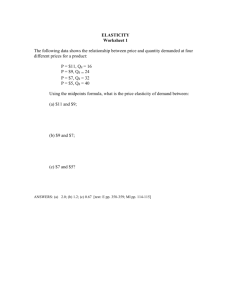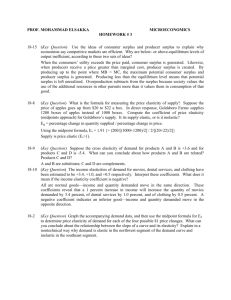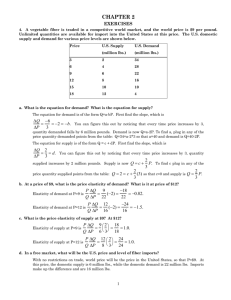B. Example: Equilibrium in the Wheat market
advertisement
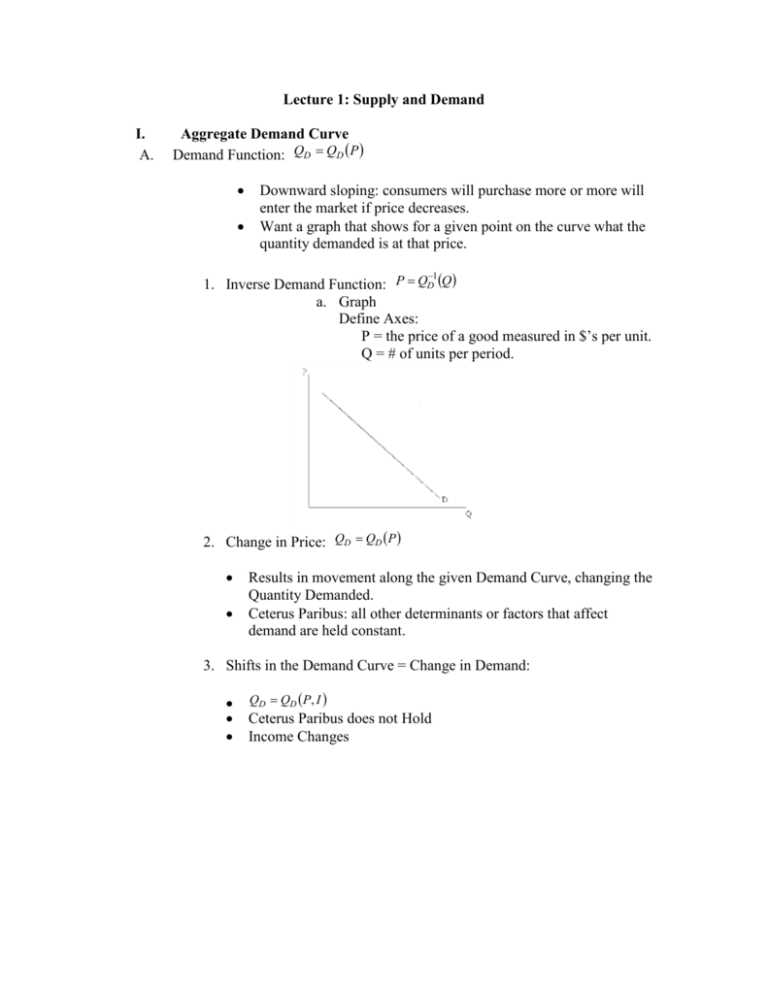
Lecture 1: Supply and Demand I. A. Aggregate Demand Curve Demand Function: QD QD P Downward sloping: consumers will purchase more or more will enter the market if price decreases. Want a graph that shows for a given point on the curve what the quantity demanded is at that price. 1. Inverse Demand Function: P QD Q a. Graph Define Axes: P = the price of a good measured in $’s per unit. Q = # of units per period. 1 2. Change in Price: QD QD P Results in movement along the given Demand Curve, changing the Quantity Demanded. Ceterus Paribus: all other determinants or factors that affect demand are held constant. 3. Shifts in the Demand Curve = Change in Demand: QD QD P, I Ceterus Paribus does not Hold Income Changes Prices of Related Goods Let there be two goods: X & Y. Complements – similar movement: Py Qy & Qx Substitutes – opposite movement Py Qy & Qx II. Aggregate Supply Curve A. Supply Function: QS QS P Upward Sloping: The higher the price the more firms are willing to produce because they can cover the higher opportunity costs (such as the increased use of labor and capital) to increase production. A given point on the curve tells us what the quantity supplied is at that price. Demand Schedule: P .75 .80 .85 .90 Mathematically: Direct: Inverse: 1. Qd 225 250 275 300 Qs 150 200 250 300 Qd = 750 – 500 P Qs = -600 + 1000 P P = 3/2 – 1/500 Qd P = -3/5 + 1/1000 Qs 1 Inverse Supply Function: P QS Q a. Graph 2. Change in Price: QS QS P Gives movement along the given Supply Curve, changing the Quantity Supplied. Ceterus Paribus: all other determinants or factors that affect supply are held constant. 3. Shifts in the Supply Curve = Change in Supply: QS QS P, w, r Ceterus Paribus does not Hold See a change in the quantity supplied across all market prices. Technology Changes Input Supply Other Factors: Population, Preferences, Expectations, III. Determination of Equilibrium Price and Quantity A. Graph: Equilibrium. Market Clearing: Point at which the quantity supplied equals the quantity demanded B. Example: Equilibrium in the Wheat market A statistical study of wheat prices and quantities from 1981 showed the supply and demand curves to be: QS = 1800 + 240P QD = 3550 - 266P IV. Adjustment to Changes in Demand or Supply Ceterus Paribus does not hold, curves shift A. Market Mechanism i) Leads to a new equilibrium price and quantity. ii) Tendency of market towards a clearing price. Assumes Competitive Markets: Sellers and Buyers do not have market power. Disequilibria puts pressure on prices to adjust Shortage: QD QS at price P0. Surplus: QD QS at price P0. Example: Market Adjustment After a Shift in Demand o The price of corn decreases – the demand curve for wheat shifts back At 1, we are at the original equilibrium. At 2, for price P* surplus results at the original price. At 3, price must decrease to P*’. Wheat Example Continued New Demand: QD = 2580 - 194P New market clearing price: 1800 + 240P = 2580 – 194P P= B. Market Intervention: can prevent prices from adjusting Price Ceiling C. V. Price Floor o Farmer price supports o An example of a wheat price floor Market Mechanism with a Shift in Both Supply and Demand The ambiguity of price/quantity directions. Let D & S shift out Think about how this price ambiguity relates to. Price Elasticity of Demand Elasticity measures the sensitivity of one variable to another. A. Price Elasticity of Demand: The percentage change in quantity demanded divided by the percentage change in price Measures the responsiveness of quantity demanded to a change in the product’s price. o Along the Demand curve. o The percent change in quantity from a 1 % increase in price. The relationship is always negative. o Convention just leaves off the sign. The Types of Price Elasticity Elastic: E p 1 Inelastic: E p 1 Unit Elastic: E p 1 Price Elasticity Formula: Q Q Q P %Q Ep P %P P Q P o Elasticity can change when moving along the demand curve: Therefore the point elasticity formula is for a small change in price and quantity. B. C. Application: How price elasticity affects the total revenue to the firm. a. Total Revenue: TR = P x Q b. In an Elastic market: % decrease in Q > % increase in P → decrease in TR c. In an Inelastic market: % decrease in Q < % increase in P → increase in TR Long run and Short run Demand. Generally, demand is more price elastic in the long run than in the short run. In long run, consumers can find more substitutes or change their consumption. Exception: Durable goods People must purchase the item in the long run. Durable goods have a more price elastic demand in the short run. D. Problem The table shows the retail price and sales for instant coffee and roasted coffee for 1997 and 1998. Year 1997 Retail Price of Sales of Instant Instant Coffee Coffee ($/lb) (million lbs) 10.35 75 Retail Price of Roasted Coffee ($/lb) 4.11 Sales of Roasted Coffee (Million lbs) 820 1998 10.48 3.76 850 70 a. Using this data alone, estimate the short run price elasticity of demand for roasted coffee. Also, derive a linear demand curve for roasted coffee. To find elasticity, first estimate the slope of the demand curve: Q P Given the slope, we can now estimate elasticity using the price and quantity data from the table. Since the demand curve is assumed to be linear, the elasticity will differ in 1997 and 1998 because price and quantity are difference. You can calculate the elasticity at both points and at the average point between the two years: E 97 p P Q Q P E 98 p P Q Q P E AVE p P97 P98 2 Q97 Q98 2 Q P To derive the demand curve for roasted coffee, note that the slope of the demand curve and the coefficient a, use the data points from the table above. The equation for the demand curve is therefore:
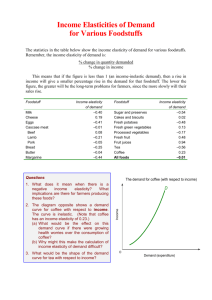
![Problem Set 2 Answer Key 1) = [ (600-500) / 500 ] / [ (7,5](http://s3.studylib.net/store/data/007545927_2-a14d6cb799111def938fd71314890ee2-300x300.png)

